
|
It brightened up to 3.7 mag and became a naked eye comet in mid January (Jan. 13, Marek Biely). It is bright as 5.7 mag still now (Mar. 6, Maik Meyer). It kept brightening even after the perihelion passage. However, it will be getting fainter gradually after this. In the Northern Hemisphere, it keeps observable in good condition after this until the comet fades out. It is not observable in the Southern Hemisphere.
Date(TT) R.A. (2000) Decl. Delta r Elong. m1 Best Time(A, h)
Mar. 7 1 28.00 57 1.7 1.409 1.399 68 5.8 19:56 (144,-25)
Mar. 14 1 25.17 59 29.3 1.523 1.442 66 6.1 19:45 (145,-28)
|
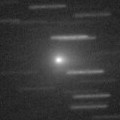
|
Now it is bright as 10.5 mag (Mar. 1, Marco Goiato). In the Southern Hemisphere, it will be getting higher gradually after this. In the Northern Hemisphere, it keeps extremely low and hard to observe until June. It will be observable in good condition after June while the comet will be fading gradually.
Date(TT) R.A. (2000) Decl. Delta r Elong. m1 Best Time(A, h)
Mar. 7 20 10.59 -21 51.0 1.895 1.399 45 9.5 4:25 (279, 27)
Mar. 14 20 36.53 -20 39.6 1.860 1.383 46 9.3 4:32 (277, 28)
|
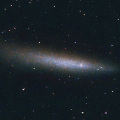
|
The spacecraft observed it brightened rapidly from 9 mag up to 2 mag when passing near by the sun. The nucleus has been already disintegrated, but the remnant is visible bright. Now it is 8.0 mag (Feb. 27, M. Masek, et al.). In the Northern Hemisphere, it will be observable and getting higher rapidly. It is not observable in the Southern Hemisphere.
Date(TT) R.A. (2000) Decl. Delta r Elong. m1 Best Time(A, h)
Mar. 7 0 40.83 27 16.7 0.899 0.649 39 9.5 19:56 (112,-18)
Mar. 14 1 33.11 37 48.9 1.031 0.843 49 10.5 19:45 (126,-17)
|
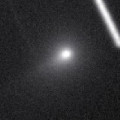
|
Bright new comet. Now it is 11.5 mag (Feb. 26, Michael Mattiazzo). It will be unobservable soon in the Southern Hemisphere. It keeps locating extremely low and hard to observe also in the Northern Hemisphere. It will be getting higher gradually after May, but the comet will be fainter than 15 mag.
Date(TT) R.A. (2000) Decl. Delta r Elong. m1 Best Time(A, h)
Mar. 7 0 57.53 -4 35.2 1.431 0.713 27 11.8 19:56 ( 87, 3)
Mar. 14 1 4.95 4 34.6 1.525 0.737 23 12.1 19:45 ( 93, -4)
|
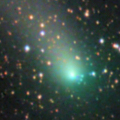
|
The brightness evolution has slowed down before the perihelion passage, and it faded down to 11.6 mag in late October (Oct. 26, Todd Augustyniak). However, an outburst occured around Nov. 10-12, and it brightened by 2 mag. It is bright as 11.7 mag still now (Feb. 16, Jakub Cerny). In the Northern Hemisphere, it will be observable in excellent condition after this while the comet will be fading. It is observable in the morning low sky until early April also in the Southern Hemisphere.
Date(TT) R.A. (2000) Decl. Delta r Elong. m1 Best Time(A, h)
Mar. 7 17 53.43 29 39.7 2.201 2.301 82 11.8 4:25 (214, 16)
Mar. 14 17 45.49 33 56.2 2.168 2.372 89 11.9 4:32 (203, 17)
|
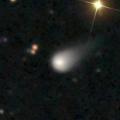
|
It brightened up to 13.6 mag until the end of 2014, brighter than originally expected (Dec. 19, Chris Wyatt). It is expected to brighten up to 4 mag from autumn to winter in 2015. Now it is not observable. In the Southern Hemisphere, it will be observable in good condition again after late March. In the Northern Hemisphere, it is hardly observable until 2015 December.
Date(TT) R.A. (2000) Decl. Delta r Elong. m1 Best Time(A, h)
Mar. 7 22 55.95 -22 8.2 4.698 3.759 16 12.6 4:25 (302, -5)
Mar. 14 23 0.57 -21 56.2 4.594 3.681 20 12.5 4:32 (297, 0)
|
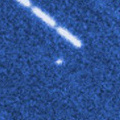
|
Now it is 15.1 mag (Feb. 1, Taras Prystavski). It will brighten up to 10.5 mag in 2015 spring. But the condition of this apparition is bad. It is already unobservable in the Northern Hemisphere. It will be unobservable in mid March also in the Southern Hemisphere. In the Northern Hemisphere, it will be observable after 2015 autumn while the comet will be fading.
Date(TT) R.A. (2000) Decl. Delta r Elong. m1 Best Time(A, h)
Mar. 7 0 39.14 -14 50.1 2.499 1.645 24 12.9 19:56 ( 76, 5)
Mar. 14 0 56.22 -11 58.7 2.477 1.603 22 12.6 19:45 ( 78, 4)
|
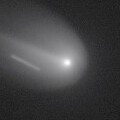
|
It brightened very rapidly in outburst up to 8.8 mag in mid December (Dec. 19, Marco Goiato). Then it faded down to 10.7 mag (Jan. 14, Chris Wyatt). However, it brightened in outburst again on Jan. 16, and brightened up to 7.0 mag (Jan. 17, Maik Meyer). Now it is 11.1 mag and diffuse (Feb. 15, Jakub Cerny). In the Northern Hemisphere, it keeps high within March. In the Southern Hemisphere, it keeps locating extremely low after this.
Date(TT) R.A. (2000) Decl. Delta r Elong. m1 Best Time(A, h)
Mar. 7 2 19.57 18 55.8 1.730 1.385 53 12.7 19:56 (118, 6)
Mar. 14 2 45.29 21 6.5 1.819 1.449 52 13.3 19:45 (121, 6)
|
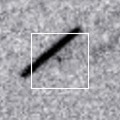
|
It will brighten up to 11 mag in spring. But the condition is bad in this apparition. In the Southern Hemisphere, it will become observable in the morning extremely low sky after late April. It will not be observable until late July in the Northern Hemisphere.
Date(TT) R.A. (2000) Decl. Delta r Elong. m1 Best Time(A, h)
Mar. 7 22 13.37 -11 22.0 2.299 1.362 14 13.2 4:25 (287, -4)
Mar. 14 22 37.45 -10 13.3 2.297 1.368 15 12.8 4:32 (284, -2)
|
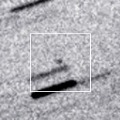
|
It was observed at 16.0 mag in December (Dec. 22, Ken-ichi Kadota). It must have brightened up to 11 mag from January to February, but no observations have been reported. In the Southern Hemisphere, it is observable in the morning sky after this while the comet will be fading. It is hardly observable in the Northern Hemisphere.
Date(TT) R.A. (2000) Decl. Delta r Elong. m1 Best Time(A, h)
Mar. 7 21 25.34 -20 57.5 2.086 1.313 29 13.0 4:25 (288, 11)
Mar. 14 21 50.51 -20 19.1 2.099 1.343 30 13.5 4:32 (286, 13)
|

|
It brightened up to 6.9 mag in autumn (Oct. 17, Marco Goiato). Now it is fading. But it is bright as 12.6 mag still now (Feb. 9, Chris Wyatt). In the Southern Hemisphere, it is getting lower and it will be unobservable temporarily in March. But it will be observable in good condition again after April. It will be observable again in mid June also in the Northern Hemisphere.
Date(TT) R.A. (2000) Decl. Delta r Elong. m1 Best Time(A, h)
Mar. 7 0 24.71 -20 29.7 3.835 2.955 23 13.4 19:56 ( 69, 6)
Mar. 14 0 28.15 -19 43.1 3.938 3.035 21 13.6 19:45 ( 68, 3)
|
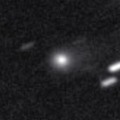
|
Now it is 14.5 mag (Jan. 20, Taras Prystavski). In 2015, it keeps 13 mag and will be observable in good condition for a long time.
Date(TT) R.A. (2000) Decl. Delta r Elong. m1 Best Time(A, h)
Mar. 7 18 31.57 -12 42.1 3.708 3.468 68 13.7 4:25 (255, 42)
Mar. 14 18 39.91 -12 21.6 3.617 3.464 73 13.7 4:32 (249, 47)
|
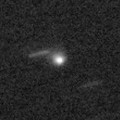
|
It will approach to the sun down to 0.3 a.u. in 2015 July, and it is expected to be bright. Now it is 15.6 mag (Jan. 13, Yasukazu Ikari). Hard to observe for a while after this. In the Southern Hemisphere, it will be observable after mid July in 2015, and keeps observable while the comet will be fading gradually. It will not be observable after this in the Northern Hemisphere.
Date(TT) R.A. (2000) Decl. Delta r Elong. m1 Best Time(A, h)
Mar. 7 23 47.10 -10 43.7 3.390 2.423 10 14.0 19:56 ( 72, -7)
Mar. 14 23 55.52 -9 10.5 3.300 2.321 8 13.7 19:45 ( 72,-10)
|

|
Now it is 15 mag (Feb. 26, Richard Miles). It is getting higher gradually in the morning sky.
Date(TT) R.A. (2000) Decl. Delta r Elong. m1 Best Time(A, h)
Mar. 7 17 48.88 -30 53.2 6.185 6.063 78 13.8 4:25 (273, 59)
Mar. 14 17 51.83 -30 59.4 6.072 6.061 84 13.8 4:32 (269, 65)
|
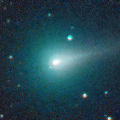
|
It brightened up to 10.6 mag from autumn to winter (Nov. 29, Seiichi Yoshida). Now it is 12.4 mag (Feb. 19, Taras Prystavski). It will be fading graudually after this. But it keeps observable for a long time until the comet fades out.
Date(TT) R.A. (2000) Decl. Delta r Elong. m1 Best Time(A, h)
Mar. 7 17 22.36 -14 28.1 1.860 2.033 85 14.0 4:25 (241, 56)
Mar. 14 17 29.46 -14 31.9 1.846 2.102 90 14.3 4:32 (232, 61)
|
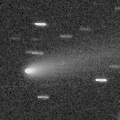
|
Now it is 13.4 mag (Feb. 15, Jakub Cerny). It is fainter than originally predicted by 2 mag. In the Northern Hemisphere, it keeps observable at 14 mag in excellent condition from 2014 summer to 2015 spring. It locates somewhat low in the Southern Hemisphere.
Date(TT) R.A. (2000) Decl. Delta r Elong. m1 Best Time(A, h)
Mar. 7 11 34.87 20 28.5 1.385 2.354 163 14.2 0:39 (180, 35)
Mar. 14 11 29.32 20 37.3 1.419 2.385 162 14.3 0:06 (180, 34)
|
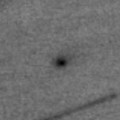
|
Now it is 17.4 mag (Jan. 18, Catalina Sky Survey). It is expected to brighten rapidly and will be observable in good condition at 13 mag from March to May.
Date(TT) R.A. (2000) Decl. Delta r Elong. m1 Best Time(A, h)
Mar. 7 15 48.14 -18 18.2 0.610 1.308 106 14.8 4:25 (201, 72)
Mar. 14 16 21.03 -19 9.1 0.565 1.273 106 14.4 4:32 (200, 73)
|
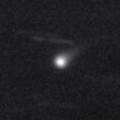
|
Brightening very rapidly. Now it is so bright as 14.5 mag and visible visually (Feb. 7, Mike Wolle). It keeps observable at 15 mag in good condition from winter to spring.
Date(TT) R.A. (2000) Decl. Delta r Elong. m1 Best Time(A, h)
Mar. 7 8 48.82 10 18.7 2.650 3.511 145 14.7 21:49 (180, 45)
Mar. 14 8 46.92 10 14.5 2.698 3.500 137 14.6 21:20 (180, 45)
|
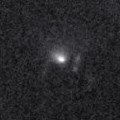
|
Now it is 15.6 mag (Jan. 19, Catalina Sky Survey). It will brighten up to 11 mag in 2015 autumn. In this apparition, it is observable until the highlight while the comet is brightening.
Date(TT) R.A. (2000) Decl. Delta r Elong. m1 Best Time(A, h)
Mar. 7 13 11.56 -0 32.5 1.723 2.621 148 15.3 2:15 (180, 56)
Mar. 14 13 8.38 0 7.6 1.638 2.579 156 15.0 1:45 (180, 55)
|

|
It brightened up to 11-12 mag in 2012. It has already faded down to 16.0 mag (Feb. 14, Taras Prystavski). It keeps observable at 15 mag in good condition until 2015 summer.
Date(TT) R.A. (2000) Decl. Delta r Elong. m1 Best Time(A, h)
Mar. 7 11 35.35 -8 49.2 8.141 9.100 164 15.1 0:40 (180, 64)
Mar. 14 11 31.02 -8 25.8 8.160 9.137 168 15.2 0:08 (180, 64)
|
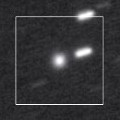
|
Very far object. However, outburst occured on Feb. 20, and now it brightened up to 15.8 mag (Feb. 24, Jean-Francois Soulier). It is also visible visually at 14.0 mag (Feb. 27, Marco Goiato). It locates high in the Southern Hemisphere. But it locates somewhat low in the Northern Hemisphere.
Date(TT) R.A. (2000) Decl. Delta r Elong. m1 Best Time(A, h)
Mar. 7 12 16.92 -23 44.4 8.314 9.155 146 15.2 1:21 (180, 79)
Mar. 14 12 15.09 -23 36.1 8.265 9.153 151 15.2 0:52 (180, 79)
|
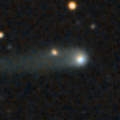
|
Now it is 15.3 mag (Jan. 7, Taras Prystavski). It keeps 15 mag for a long time from 2014 to 2015. It is observable in excellent condition in 2014 in the Southern Hemisphere, or in 2015 in the Northern Hemisphere. It becomes unobservable temporarily from March to May.
Date(TT) R.A. (2000) Decl. Delta r Elong. m1 Best Time(A, h)
Mar. 7 0 46.10 -0 56.5 4.760 3.883 24 15.3 19:56 ( 88, -1)
Mar. 14 0 51.39 0 39.3 4.804 3.882 19 15.3 19:45 ( 88, -5)
|
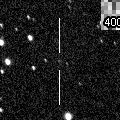
|
It brightened rapidly. Now it is 15.7 mag, much brighter than origianlly predicted (Jan. 31, Hidetaka Sato). It keeps 15 mag in March.
Date(TT) R.A. (2000) Decl. Delta r Elong. m1 Best Time(A, h)
Mar. 7 15 42.32 -19 52.2 0.993 1.606 107 15.4 4:25 (198, 74)
Mar. 14 15 54.31 -21 56.5 0.964 1.622 111 15.4 4:30 (180, 77)
|
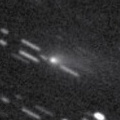
|
It brightened up to 2 mag by unusual major outburst in 2007. It brightened up to 12.6 mag in this apparition (June 25, Taras Prystavski). It faded down to 17-18 mag, but it suddenly brightened in outburst on Jan. 26, and brightened up to 13.2 mag (Jan. 29, Uwe Pilz). Now it is 14.7 mag (Feb. 7, Sandor Szabo). In the Northern Hemisphere, it keeps observable in good condition. In the Southern Hemisphere, it keeps extremely low.
Date(TT) R.A. (2000) Decl. Delta r Elong. m1 Best Time(A, h)
Mar. 7 4 35.49 38 34.8 3.051 3.162 87 15.4 19:56 (153, 10)
Mar. 14 4 43.54 38 4.1 3.176 3.191 81 15.8 19:45 (151, 9)
|

|
Now it is 15.8 mag (Feb. 22, Taras Prystavski). It will brighten up to 14 mag from 2015 to 2016. It is observable in good condition in the Southern Hemisphere. It locates somewhat low in the Northern Hemisphere.
Date(TT) R.A. (2000) Decl. Delta r Elong. m1 Best Time(A, h)
Mar. 7 2 47.64 -8 54.0 4.954 4.452 54 15.5 19:56 ( 99, 28)
Mar. 14 2 47.75 -7 38.0 5.028 4.432 48 15.5 19:45 ( 98, 24)
|

|
Now it is 14.5 mag (Nov. 19, Taras Prystavski). It will be observable at 15-16 mag in good condition again in 2015.
Date(TT) R.A. (2000) Decl. Delta r Elong. m1 Best Time(A, h)
Mar. 7 18 59.85 -17 10.3 7.869 7.450 61 15.6 4:25 (264, 38)
Mar. 14 19 0.47 -17 24.6 7.785 7.478 68 15.6 4:32 (259, 45)
|
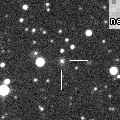
|
Now it is 15.4 mag (Feb. 21, Taras Prystavski). In the Northern Hemisphere, it keeps 15-16 mag and observable in excellent condition for a long time until early summer in 2015. It locates somewhat low in the Southern Hemisphere.
Date(TT) R.A. (2000) Decl. Delta r Elong. m1 Best Time(A, h)
Mar. 7 13 27.71 34 48.2 2.964 3.746 136 15.6 2:32 (180, 20)
Mar. 14 13 23.29 34 50.6 2.961 3.769 139 15.6 2:00 (180, 20)
|
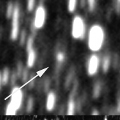
|
Now it is 16.7 mag (Sept. 23, Taras Prystavski). Distant object, but it keeps observable at 14 mag for a long time from 2015 to 2016.
Date(TT) R.A. (2000) Decl. Delta r Elong. m1 Best Time(A, h)
Mar. 7 20 43.34 -5 13.6 6.607 5.833 36 15.8 4:25 (269, 11)
Mar. 14 20 48.79 -4 51.1 6.518 5.807 41 15.7 4:32 (264, 17)
|
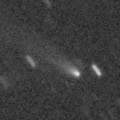
|
Now it is 15.3 mag (Feb. 23, Mitsunori Tsumura). It keeps observable in good condition after this in the Northern Hemisphere, but it will be fading gradually. It locates low in the Southern Hemisphere.
Date(TT) R.A. (2000) Decl. Delta r Elong. m1 Best Time(A, h)
Mar. 7 3 38.85 26 14.6 1.409 1.464 72 15.7 19:56 (136, 13)
Mar. 14 4 4.52 27 34.5 1.473 1.497 71 16.0 19:45 (139, 14)
|
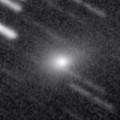
|
Now it is bright as 13.8 mag (Feb. 15, Jakub Cerny). It keeps 14-15 mag until February, and it will be observable in excellent condition in the Northern Hemisphere. It locates somewhat low in the Southern Hemisphere.
Date(TT) R.A. (2000) Decl. Delta r Elong. m1 Best Time(A, h)
Mar. 7 6 26.89 20 38.1 1.999 2.522 110 15.8 19:56 (172, 34)
Mar. 14 6 31.92 20 12.8 2.090 2.531 104 15.9 19:45 (169, 34)
|
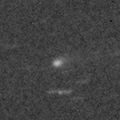
|
Now it is 16.2 mag (Feb. 23, Mitsunori Tsumura). It keeps observable in good condition after this, but it will be fading gradually.
Date(TT) R.A. (2000) Decl. Delta r Elong. m1 Best Time(A, h)
Mar. 7 12 12.58 8 49.6 1.316 2.285 163 16.0 1:17 (180, 46)
Mar. 14 12 7.90 9 38.6 1.327 2.311 169 16.1 0:45 (180, 45)
|

|
Now it is 15.7 mag (Jan. 16, Taras Prystavski). It will pass close to the earth from spring to summer in 2016, and it is expected to be observable at 6-7 mag in good condition. In the Northern Hemispehre, it keeps observable in good condition until 2015 spring when the comet will brighten up to 15.5 mag. In the Southern Hemisphere, it keeps low for a long time until 2016 spring.
Date(TT) R.A. (2000) Decl. Delta r Elong. m1 Best Time(A, h)
Mar. 7 4 48.99 34 37.4 5.006 5.091 89 16.1 19:56 (154, 14)
Mar. 14 4 46.79 34 21.0 5.068 5.026 81 16.0 19:45 (150, 13)
|
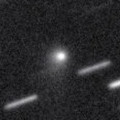
|
Now it is 15.8 mag (Jan. 11, Y. Sugiyama). It keeps observable at 15-16 mag for a long time from 2015 to 2016. In the Northern Hemisphere, it is observable in excellent condition. It locates somewhat low in the Southern Hemisphere.
Date(TT) R.A. (2000) Decl. Delta r Elong. m1 Best Time(A, h)
Mar. 7 3 0.88 31 33.0 5.748 5.432 66 16.1 19:56 (133, 4)
Mar. 14 3 3.73 32 8.8 5.832 5.416 60 16.2 19:45 (132, 1)
|

|
Now it is 17.6 mag (Feb. 23, Mitsunori Tsumura). It will brighten up to 13 mag in 2016. In the Northern Hemisphere, it will be observable in excellent condition in this winter. It locates somewhat low in the Southern Hemisphere. It is fainter than this ephemeris recently.
Date(TT) R.A. (2000) Decl. Delta r Elong. m1 Best Time(A, h)
Mar. 7 5 45.32 27 28.4 2.621 2.971 100 16.3 19:56 (163, 25)
Mar. 14 5 49.18 27 21.4 2.692 2.945 94 16.3 19:45 (160, 25)
|
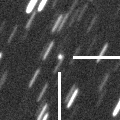
|
Brightened rapidly. Now it is bright as 15.6 mag (Feb. 12, Catalina Sky Survey). It is observable in excellent condition in the Northern Hemisphere. But it will be fading after this, and will be fainter than 18 mag in May. It is not observable in the Southern Hemisphere.
Date(TT) R.A. (2000) Decl. Delta r Elong. m1 Best Time(A, h)
Mar. 7 5 59.79 54 50.0 1.449 1.919 101 16.5 19:56 (172, -1)
Mar. 14 6 18.51 54 21.0 1.525 1.944 98 16.6 19:45 (173, 0)
|
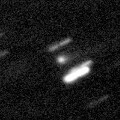
|
Now it is 16.1 mag (Feb. 22, Taras Prystavski). It keeps observable at 16-17 mag in good condition for a while.
Date(TT) R.A. (2000) Decl. Delta r Elong. m1 Best Time(A, h)
Mar. 7 7 52.90 13 53.5 3.406 4.129 131 16.6 20:54 (180, 41)
Mar. 14 7 52.58 14 0.2 3.492 4.135 124 16.6 20:26 (180, 41)
|
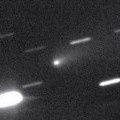
|
Now it is 14.4 mag (Feb. 15, Taras Prystavski). It keeps observable for a long time after this while the comet will be fading gradually.
Date(TT) R.A. (2000) Decl. Delta r Elong. m1 Best Time(A, h)
Mar. 7 9 13.15 5 20.7 2.070 2.979 151 16.6 22:13 (180, 50)
Mar. 14 9 10.13 6 4.0 2.159 3.020 144 16.8 21:43 (180, 49)
|
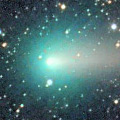
|
It brightened up to 6.5 mag in September (Sept. 21, Marco Goiato). Now it is fading rapidly. It has already faded, fainter than 17.7 mag (Feb. 15, Taras Prystavski).
Date(TT) R.A. (2000) Decl. Delta r Elong. m1 Best Time(A, h)
Mar. 7 15 15.05 15 36.1 2.129 2.747 118 16.7 4:19 (180, 40)
Mar. 14 15 1.32 18 12.2 2.125 2.837 126 16.8 3:38 (180, 37)
|
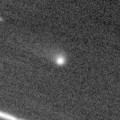
|
Now it is 16.1 mag (Feb. 15, Taras Prystavski). It keeps 17-18 mag for a long time from 2014 to 2016.
Date(TT) R.A. (2000) Decl. Delta r Elong. m1 Best Time(A, h)
Mar. 7 12 21.51 -23 53.2 4.504 5.351 145 16.8 1:26 (180, 79)
Mar. 14 12 11.44 -23 35.9 4.457 5.355 152 16.7 0:48 (180, 79)
|
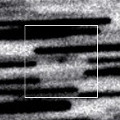
|
Now it is 19.2 mag (Feb. 21, Jean-Francois Soulier). It is expected to brighten up to 15 mag in summer, and will be observable in excellent condition. But it is fainter than this ephemeris.
Date(TT) R.A. (2000) Decl. Delta r Elong. m1 Best Time(A, h)
Mar. 7 19 30.39 -19 29.7 2.253 1.864 54 17.1 4:25 (271, 33)
Mar. 14 19 49.02 -18 40.1 2.180 1.842 57 16.9 4:32 (268, 36)
|
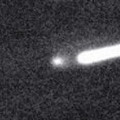
|
It brightened up to 15.5 mag from autumn to winter (Nov. 25, Taras Prystavski). Now it is fading. It has already faded down to 16.6 mag (Feb. 15, Taras Prystavski). It keeps observable in good condition for a while.
Date(TT) R.A. (2000) Decl. Delta r Elong. m1 Best Time(A, h)
Mar. 7 17 23.28 -10 50.0 1.966 2.127 85 16.9 4:25 (236, 53)
Mar. 14 17 32.47 -10 34.4 1.923 2.162 89 16.9 4:32 (228, 57)
|

|
Now it is 16.8 mag (Jan. 23, Catalina Sky Survey). It keeps 13 mag for a long time from 2015 to 2016, and will be observable in excellent condition in the Northern Hemisphere. In the Southern Hemisphere, it is observable only until mid 2015 March.
Date(TT) R.A. (2000) Decl. Delta r Elong. m1 Best Time(A, h)
Mar. 7 3 40.54 24 41.6 4.726 4.532 72 16.9 19:56 (135, 15)
Mar. 14 3 41.87 25 23.2 4.787 4.481 66 16.9 19:45 (133, 12)
|

|
Now it is 17.7 mag (Jan. 20, Taras Prystavski). It was observed at 17 mag in 2014 summer. In the Northern Hemisphere, it is observable at 17.5 mag in excellent condition also in 2015. It is not observable in the Southern Hemisphere.
Date(TT) R.A. (2000) Decl. Delta r Elong. m1 Best Time(A, h)
Mar. 7 20 30.60 36 59.5 4.440 3.974 56 17.2 4:25 (233,-12)
Mar. 14 20 41.51 38 2.7 4.442 3.990 57 17.2 4:32 (229, -8)
|
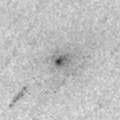
|
It brightened up to 15.4 mag in autumn (Nov. 19, Taras Prystavski). But it was extremely diffuse. It was reported so faint as 20 mag after December. It keeps observable in excellent condition in the Southern Hemisphere. But it locates low in the Northern Hemisphere.
Date(TT) R.A. (2000) Decl. Delta r Elong. m1 Best Time(A, h)
Mar. 7 8 24.87 -38 43.3 1.810 2.481 121 17.2 21:25 ( 0, 86)
Mar. 14 8 22.43 -38 7.5 1.892 2.537 119 17.4 20:55 ( 0, 87)
|
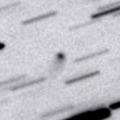
|
Now it is 17.5 mag (Dec. 1, Alexander Baransky). It keeps observable at 17-18 mag for a long time from 2013 to 2016. It keeps locating high in the Northern Hemisphere. It keeps locating very low in the Southern Hemipshere.
Date(TT) R.A. (2000) Decl. Delta r Elong. m1 Best Time(A, h)
Mar. 7 17 24.20 54 53.8 6.489 6.602 92 17.3 4:25 (197, -4)
Mar. 14 17 21.32 56 18.5 6.467 6.612 94 17.3 4:32 (192, -3)
|
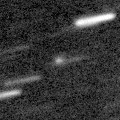
|
Now it is 17.6 mag (Jan. 22, A. Maury, J.-F. Soulier, J.-G. Bosch, T. Noel). It keeps observable at 17 mag from spring to summer. It locates somewhat low in the Northern Hemisphere.
Date(TT) R.A. (2000) Decl. Delta r Elong. m1 Best Time(A, h)
Mar. 7 16 58.50 -28 52.6 2.990 3.140 89 17.3 4:25 (260, 69)
Mar. 14 17 4.59 -28 59.2 2.894 3.141 95 17.3 4:32 (252, 74)
|
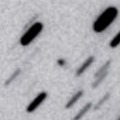
|
Now it is 17.8 mag (Jan. 6, B. Lutkenhoner). It was observed around 17-18 mag in early 2014. It will be observable around 17-18 mag again from 2014 autumn to 2015 spring, in excellent condition in the Northern Hemisphere. It is not observable in the Southern Hemisphere.
Date(TT) R.A. (2000) Decl. Delta r Elong. m1 Best Time(A, h)
Mar. 7 10 9.46 55 59.6 4.541 5.214 128 17.5 23:10 (180, -1)
Mar. 14 10 4.18 55 18.0 4.596 5.224 124 17.5 22:37 (180, 0)
|
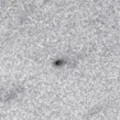
|
Now it is 17.6 mag (Jan. 21, Catalina Sky Survey). Now it is around the aphelion. In the Northern Hemisphere, it is observable at 18 mag in good condition from winter to spring. It locates somewhat low in the Southern Hemisphere.
Date(TT) R.A. (2000) Decl. Delta r Elong. m1 Best Time(A, h)
Mar. 7 8 35.48 29 20.0 3.792 4.567 136 17.6 21:36 (180, 26)
Mar. 14 8 32.78 29 19.3 3.859 4.557 129 17.6 21:06 (180, 26)
|
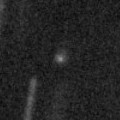
|
Now it is 18.0 mag (Jan. 23, K. Hills). It keeps observable at 17 mag from winter to spring. It is observable in excellent condition in the Southern Hemisphere. But it locates somewhat low in the Northern Hemisphere.
Date(TT) R.A. (2000) Decl. Delta r Elong. m1 Best Time(A, h)
Mar. 7 11 5.45 -27 28.4 2.210 3.090 146 17.6 0:10 (180, 82)
Mar. 14 10 55.20 -28 44.7 2.206 3.088 147 17.6 23:27 (180, 84)
|

|
First return of a peculiar asteroid 1998 HO121. It keeps observable at 17-18 mag from 2015 to 2016.
Date(TT) R.A. (2000) Decl. Delta r Elong. m1 Best Time(A, h)
Mar. 7 6 53.90 10 4.5 2.544 3.122 116 17.7 19:56 (180, 45)
Mar. 14 6 56.33 10 36.8 2.613 3.108 110 17.8 19:45 (175, 44)
|
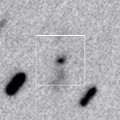
|
Now it is 20.0 mag (Dec. 27, Takaaki Oribe). It will brighten up to 14 mag and will be observable in good condition in 2016.
Date(TT) R.A. (2000) Decl. Delta r Elong. m1 Best Time(A, h)
Mar. 7 13 6.19 -1 8.3 3.046 3.935 149 17.9 2:10 (180, 56)
Mar. 14 13 3.31 -0 37.2 2.964 3.901 157 17.7 1:40 (180, 56)
|
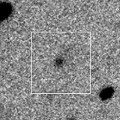
|
It will brighten up to 14 mag in 2016 spring. Now it is 17.1 mag (Jan. 22, Mt. Lemmon Survey). In 2015, it is observable in good condition until spring in the Northern Hemisphere. In the Southern Hemisphere, it is not observable in 2015. But it will be observable in good condition at the high light in 2016.
Date(TT) R.A. (2000) Decl. Delta r Elong. m1 Best Time(A, h)
Mar. 7 7 15.94 39 38.4 3.510 4.070 117 17.8 20:17 (180, 15)
Mar. 14 7 15.18 39 11.9 3.545 4.013 111 17.8 19:49 (180, 16)
|
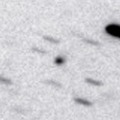
|
Now it is 17.0 mag (Dec. 30, Space Surveillance Telescope, Atom Site). It keeps 18 mag from 2014 to 2015. In 2015, it keeps observable in good condition from winter to spring.
Date(TT) R.A. (2000) Decl. Delta r Elong. m1 Best Time(A, h)
Mar. 7 10 39.73 -10 57.1 5.049 6.001 162 17.8 23:40 (180, 66)
Mar. 14 10 36.63 -10 59.3 5.068 6.013 160 17.8 23:09 (180, 66)
|
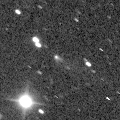
|
Now it is 17.2 mag (Jan. 10, Toshiyuki Takahashi). It was observed at 17 mag from 2013 to early 2014. It will be observable at 17.5 mag in good condition again from autumn to winter in 2014.
Date(TT) R.A. (2000) Decl. Delta r Elong. m1 Best Time(A, h)
Mar. 7 7 56.88 14 32.6 2.740 3.485 132 17.8 20:58 (180, 40)
Mar. 14 7 56.35 14 41.7 2.833 3.501 125 17.9 20:30 (180, 40)
|
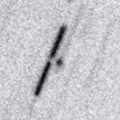
|
It keeps observable at 18 mag from 2014 to 2015 in the Northern Hemispehre. It is not observable in the Southern Hemispehre.
Date(TT) R.A. (2000) Decl. Delta r Elong. m1 Best Time(A, h)
Mar. 7 15 11.61 65 4.9 3.951 4.346 106 17.9 4:15 (180,-10)
Mar. 14 14 56.15 67 33.2 3.961 4.353 106 17.9 3:32 (180,-12)
|
|
![]()
 P/2014 X1 ( Elenin )
P/2014 X1 ( Elenin ) 269P/2012 R2 ( Jedicke )
269P/2012 R2 ( Jedicke ) 4P/Faye
4P/Faye C/2013 V5 ( Oukaimeden )
C/2013 V5 ( Oukaimeden ) C/2013 G9 ( Tenagra )
C/2013 G9 ( Tenagra ) 57P/du Toit-Neujmin-Delporte
57P/du Toit-Neujmin-Delporte 40P/Vaisala 1
40P/Vaisala 1 C/2014 W2 ( PanSTARRS )
C/2014 W2 ( PanSTARRS ) C/2013 G3 ( PanSTARRS )
C/2013 G3 ( PanSTARRS ) C/2014 R4 ( Gibbs )
C/2014 R4 ( Gibbs ) C/2012 K8 ( Lemmon )
C/2012 K8 ( Lemmon ) 299P/2014 D2 ( Catalina-PanSTARRS )
299P/2014 D2 ( Catalina-PanSTARRS ) C/2013 U2 ( Holvorcem )
C/2013 U2 ( Holvorcem ) 65P/Gunn
65P/Gunn C/2014 W6 ( Catalina )
C/2014 W6 ( Catalina ) (347449) 2012 TW236
(347449) 2012 TW236 53P/Van Biesbroeck
53P/Van Biesbroeck C/2014 Y1 ( PanSTARRS )
C/2014 Y1 ( PanSTARRS ) C/2013 TW5 ( Spacewatch )
C/2013 TW5 ( Spacewatch ) 119P/Parker-Hartley
119P/Parker-Hartley C/2014 F2 ( Tenagra )
C/2014 F2 ( Tenagra )![]()




















































